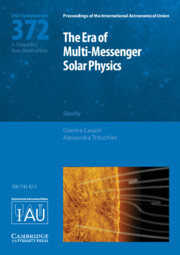The Era of Multi-Messenger Solar Physics (IAU S372) Proceedings of the International Astronomical Union Symposia and Colloquia Series
Langue : Anglais
Coordonnateurs : Cauzzi Gianna, Tritschler Alexandra

Multi-messenger science has a long history in solar astronomy, as direct measures of ?in-situ? particles emanating from the Sun, like the solar wind, have long been used alongside remote observations to shape our understanding of the heliosphere. Still, the recent advent of several major observational facilities, such as Parker Solar Probe, Solar Orbiter, and the Inouye Solar Telescope, among many others, is now heralding an exciting new era of scientific opportunities within multi-messenger solar physics. This volume collects the proceedings of IAU Symposium 372 held during the XXXIst IAU General Assembly in Busan, Republic of Korea. Its main goal is to highlight how these facilities can address many of the pressing questions facing contemporary solar physics, with a special emphasis on their coordinated operation and the resulting synergies. Graduate students and researchers in solar physics will benefit from the many new results presented within.
Part I. New Solar Facilities and Multi-Mission Science; Solar Physics in the 2020s: DKIST, Parker Solar Probe and Solar Orbiter as a multi-messenger constellation V. Martinez Pillet et al; The Aditya-L1 mission of ISRO Durgesh Tripathi et al; Solar observations with ALMA: A new frontier T. S. Bastian; Modeling efforts for multi-mission science C. Sasso and A. P. Rouillard; Part II. Magnetic Fields – Generation, Activity, and Instabilities: Solar flare-CME association Ting Li; Origin of extreme solar eruptive activity from the active region NOAA 12673 and the largest flare of solar cycle 24 Bhuwan Joshi and Prabir K. Mitra; Solar cycles reconstructed over the last millennium: Do Waldmeier and Gnevysev-Ohl rules work? Markus Similä and Ilya Usoskin; Study of ionospheric behaviour during the intense geomagnetic storms in 24th solar cycle over different latitudes and longitudes Bhupendra Malvi, Sharad C. Tripathi and P. K. Purohit; Power spectra of the Sun's large-scale magnetic field during solar cycles 23 and 24 Yukun Luo, Jie Jiang and Ruihui Wang; Long-term evolution of magnetic field proxies as deduced from archival data Dipankar Banerjee et al; Observational signature of tilt quenching of bipolar magnetic regions in the Sun Bibhuti Kumar Jha, Bidya Binay Karak and Dipankar Banerjee; Photospheric magnetic field variation during solar flares and their implication for the generation of sunquakes S. Vargas Domínguez, W. Caicedo Tez and J. C. Buitrago Casas; A new mechanism for the butterfly diagram of the solar cycle Zebin Zhang, Jie Jiang and Haowei Zhang; Automatic detection of solar active regions from SOHO/MDI and SDO/HMI synoptic magnetograms Ruihui Wang, Jie Jiang and Yukun Luo; Automatic algorithm for tracking bipolar magnetic regions Anu B. Sreedevi and Bibhuti Kuma Jha; Part III. Solar Atmosphere and Solar Wind: How has the solar wind evolved to become what it is today? A. A. Vidotto; Spectroscopic Detection of Alfvénic MHD waves in the sunspot chromosphere Jongchul Chae; Self-consistent nanoflare heating in model active regions: MHD avalanches in curved coronal arcades J. Reid, J. Threlfall and A. W. Hood; Study of the impact of coronal rain on kink oscillations of coronal loops Arpit Kumar Shrivastav and Vaibhav Pant; Understanding Weak Impulsive Narrowband Quiet Sun Emissions (WINQSEs) Divya Oberoi et al; Spatio-temporal characterization of hot chromospheric fibrils Parker Lamb, Gianna Cauzzi and Kevin Reardon; Part IV: Machine Learning in Solar Physics: Application of deep learning to solar and space weather data Yong-Jae Moon et al.
Date de parution : 11-2023
Ouvrage de 200 p.
17.8x25.3 cm
Disponible chez l'éditeur (délai d'approvisionnement : 14 jours).
Prix indicatif 152,43 €
Ajouter au panierThème de The Era of Multi-Messenger Solar Physics (IAU S372) :
© 2024 LAVOISIER S.A.S.



